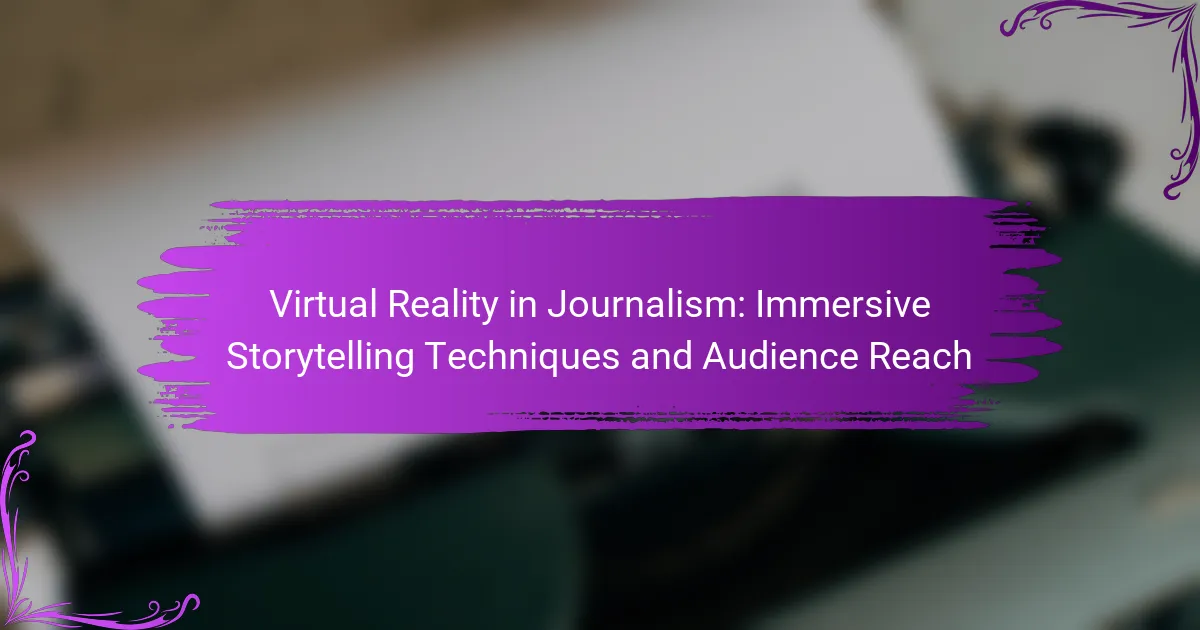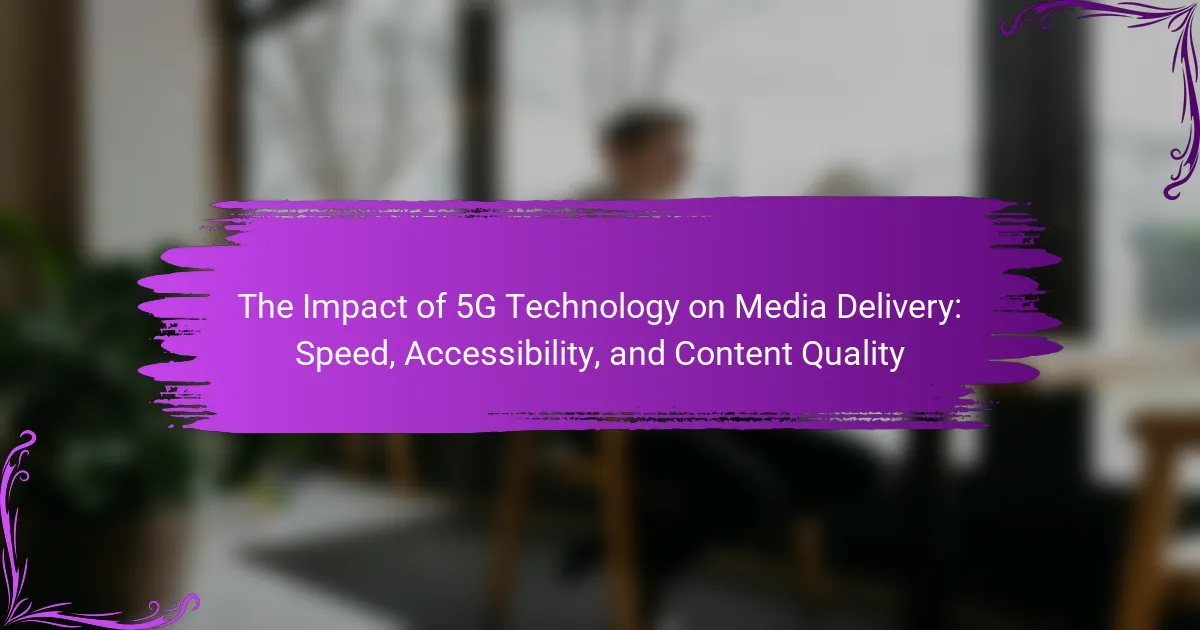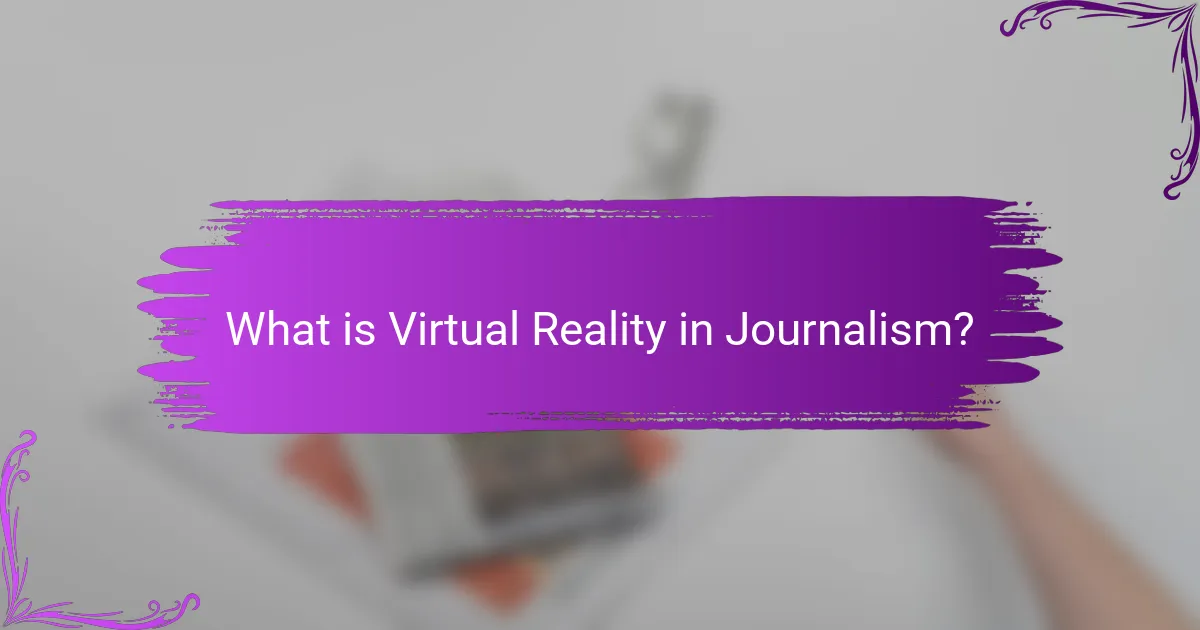
What is Virtual Reality in Journalism?
Virtual Reality in journalism is the use of immersive technology to tell news stories. It allows audiences to experience events as if they are physically present. This medium enhances engagement and emotional connection. VR can transport viewers to distant locations or critical situations. It often includes 360-degree video and interactive elements. Research shows that immersive storytelling can increase empathy among viewers. A study by the University of Southern California found that VR can enhance the retention of information. This technology is reshaping how news is reported and consumed.
How does Virtual Reality enhance storytelling in journalism?
Virtual Reality enhances storytelling in journalism by providing immersive experiences that engage audiences on a deeper level. This technology allows users to experience news events as if they are physically present. For example, VR can transport viewers to conflict zones or natural disasters, fostering empathy and understanding. According to a study by the Stanford Virtual Human Interaction Lab, participants reported feeling more connected to stories experienced in VR compared to traditional formats. Additionally, VR can convey complex narratives through interactive elements, allowing users to explore different perspectives. This interactivity can lead to increased retention of information and a more impactful storytelling experience.
What specific techniques are used in immersive storytelling?
Immersive storytelling employs techniques such as 360-degree video, interactive elements, and audio immersion. 360-degree video allows viewers to explore environments from multiple angles, enhancing engagement. Interactive elements enable audience participation, making choices that influence the narrative. Audio immersion uses spatial sound to create a realistic atmosphere, guiding emotional responses. These techniques combine to create a compelling experience that draws the audience into the story. Research shows that immersive storytelling can increase empathy and understanding, particularly in journalism. For example, a study by the University of Southern California found that virtual reality narratives can significantly enhance emotional engagement with real-world issues.
How does Virtual Reality change the narrative experience for audiences?
Virtual Reality (VR) significantly alters the narrative experience for audiences by creating immersive environments. It allows users to engage with stories in a three-dimensional space. This engagement fosters a sense of presence, making narratives more impactful. Audiences can explore story elements from various angles. This interactivity enhances emotional connections to the characters and events. Research shows that immersive storytelling can increase empathy among viewers. A study by the University of Southern California found that VR experiences lead to greater emotional responses compared to traditional media. Overall, VR transforms storytelling into a participatory experience, deepening audience involvement.
Why is audience engagement important in journalism?
Audience engagement is crucial in journalism because it fosters connection and trust between journalists and their audience. Engaged audiences are more likely to consume content, share it, and provide feedback. This interaction enhances the relevance of news stories. It also encourages journalists to tailor their content to audience interests. Research shows that engaged audiences have higher retention rates of information. For instance, a study by the Pew Research Center found that 62% of engaged readers share news articles with others. This sharing amplifies the reach of journalism. Ultimately, audience engagement is vital for the sustainability and impact of journalistic efforts.
What role does Virtual Reality play in increasing audience reach?
Virtual Reality (VR) significantly enhances audience reach by creating immersive experiences. VR allows users to engage with content in a more interactive manner. This interactivity can lead to higher levels of viewer retention. According to a study by the University of Southern California, VR experiences can increase emotional engagement by 30%. This heightened engagement often translates to sharing and discussing content more frequently. Additionally, VR can reach diverse demographics, including those who may not engage with traditional media. The unique nature of VR attracts new audiences, expanding the overall reach of journalistic content.
How does immersive content affect viewer retention?
Immersive content significantly enhances viewer retention. This type of content engages users through interactive and sensory experiences. Research indicates that immersive experiences can increase information retention by up to 70%. For instance, a study by the University of Maryland found that virtual reality environments foster deeper emotional connections. These connections lead to longer engagement times and improved recall of information presented. Furthermore, immersive storytelling techniques create a sense of presence, making viewers feel part of the narrative. This involvement encourages them to stay focused and engaged throughout the content. Overall, immersive content effectively captures attention and retains viewers longer.
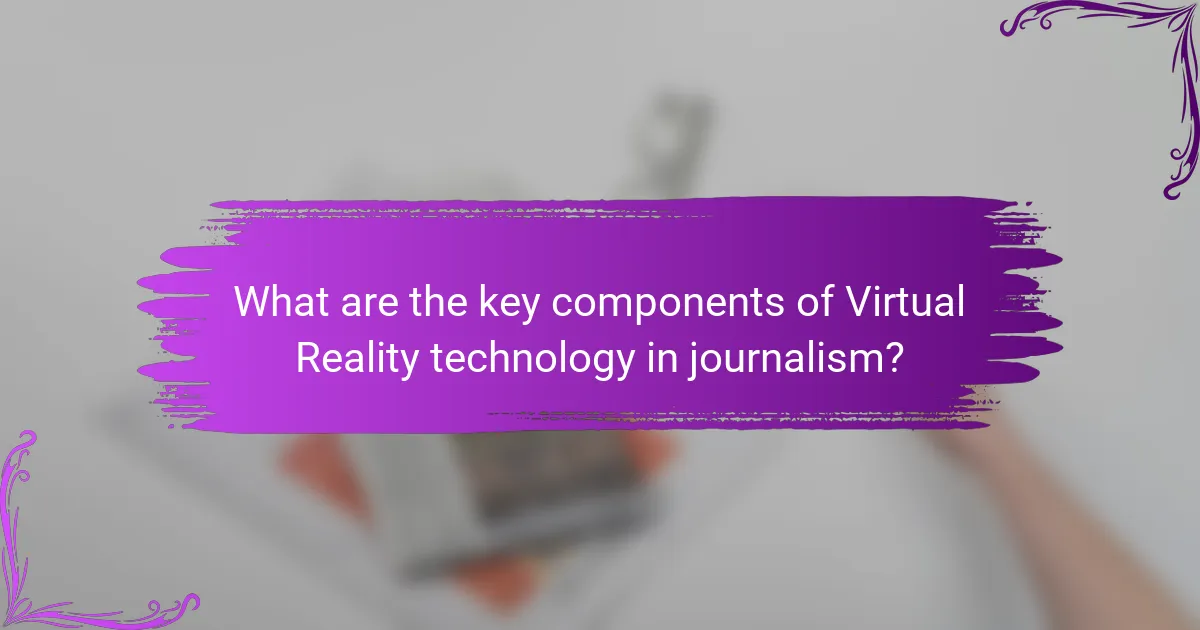
What are the key components of Virtual Reality technology in journalism?
The key components of Virtual Reality technology in journalism include immersive storytelling, 360-degree video, interactivity, and user engagement. Immersive storytelling allows journalists to create a narrative that places the audience within the story. 360-degree video captures the environment from all angles, enhancing the viewer’s experience. Interactivity enables users to make choices that influence their viewing experience, fostering a deeper connection. User engagement is crucial, as it encourages audiences to explore content actively. These components combine to create a powerful medium for delivering news and information.
What hardware is essential for creating Virtual Reality experiences?
Essential hardware for creating Virtual Reality experiences includes a VR headset, a powerful computer, and motion controllers. The VR headset provides the immersive visual experience. A powerful computer is necessary to run complex VR applications smoothly. Motion controllers allow users to interact with the virtual environment. Additional hardware may include sensors for tracking movement and audio equipment for spatial sound. These components work together to create a fully immersive experience. The quality of the VR experience is significantly influenced by the specifications of each hardware component.
How do different VR headsets compare in journalism applications?
Different VR headsets offer varying capabilities for journalism applications. The Oculus Quest 2 is known for its affordability and wireless functionality, making it accessible for news organizations. The HTC Vive Pro provides high-resolution visuals, which enhance immersive storytelling. The Valve Index is praised for its precise tracking and high refresh rates, beneficial for real-time reporting.
In contrast, the PlayStation VR is limited by its tethered nature but has a strong gaming community that can be leveraged for journalistic content. The Pico Neo 3 is emerging as a competitor with standalone capabilities and enterprise focus.
Each headset’s performance in journalism depends on factors like resolution, user comfort, and software compatibility. For instance, high-resolution headsets can deliver more detailed environments, crucial for impactful storytelling. Overall, the choice of VR headset in journalism hinges on budget, specific use cases, and audience engagement goals.
What software tools are commonly used for VR journalism?
Common software tools used for VR journalism include Unity, Unreal Engine, and Adobe Premiere Pro. Unity is widely utilized for creating interactive experiences and simulations. Unreal Engine is known for its high-fidelity graphics and real-time rendering capabilities. Adobe Premiere Pro is frequently used for editing VR video content. Other notable tools include A-Frame for web-based VR experiences and Oculus Medium for 3D modeling. These tools enable journalists to craft immersive narratives that engage audiences effectively.
What are the challenges of implementing Virtual Reality in journalism?
The challenges of implementing Virtual Reality in journalism include high production costs and the need for specialized skills. Creating immersive VR content requires significant financial investment in technology and equipment. Additionally, journalists must learn new technical skills to produce VR experiences effectively. Another challenge is the limited audience reach due to the requirement of VR headsets. Not all consumers have access to this technology, which restricts the potential audience. Furthermore, there are concerns about the ethical implications of VR storytelling. Journalists must navigate issues related to realism and representation in immersive environments. Lastly, the fast-paced nature of news can conflict with the time-consuming process of producing VR content. These challenges hinder the widespread adoption of VR in journalism.
How do technical limitations impact content creation?
Technical limitations significantly impact content creation by restricting the tools and technologies available to creators. Limited hardware can hinder the quality of virtual reality experiences. Insufficient processing power may lead to lag or poor graphics, reducing user engagement. Additionally, software constraints can limit the complexity of storytelling techniques. For instance, if a platform cannot support high-resolution visuals, the immersive experience suffers. Connectivity issues can also affect real-time collaboration among journalists. Research indicates that 70% of content creators cite technical barriers as a major challenge in VR journalism. These limitations can ultimately affect audience reach and the effectiveness of storytelling.
What ethical considerations must journalists keep in mind?
Journalists must keep several ethical considerations in mind. They should prioritize accuracy in reporting. Misrepresentation of facts can lead to misinformation. Journalists must also ensure fairness and impartiality. Bias in storytelling can distort public perception. Respect for privacy is crucial when covering sensitive topics. Infringing on individuals’ privacy can cause harm. Journalists should seek informed consent when using immersive technologies. This is particularly important in virtual reality storytelling. Transparency about sources enhances credibility. Ethical journalism promotes trust with the audience.
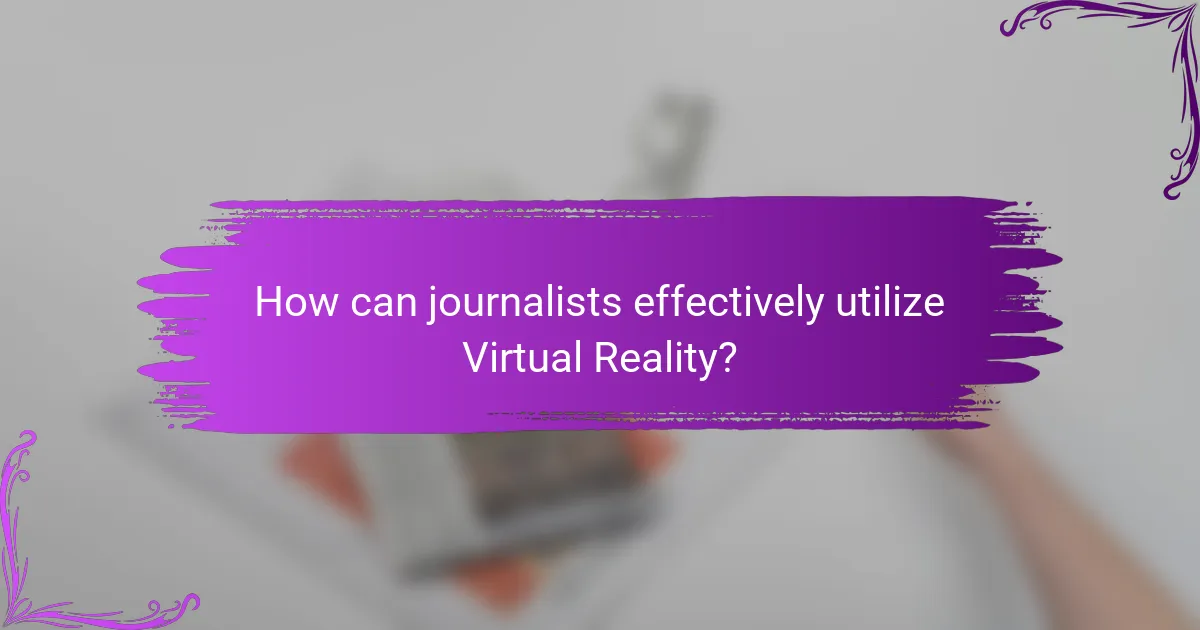
How can journalists effectively utilize Virtual Reality?
Journalists can effectively utilize Virtual Reality (VR) by creating immersive storytelling experiences. VR allows audiences to engage with content in a three-dimensional space. This technology enhances emotional connections with stories. For instance, a VR documentary can transport viewers to conflict zones, providing a first-person perspective. Research indicates that immersive experiences can increase empathy levels among viewers. A study from Stanford University found that VR can significantly enhance emotional responses to narratives. By using VR, journalists can present complex issues in a more relatable manner. This approach can lead to higher audience engagement and retention.
What best practices should journalists follow when creating VR content?
Journalists should follow several best practices when creating VR content. First, they must prioritize storytelling. A clear narrative engages viewers and enhances immersion. Second, journalists should consider the viewer’s perspective. VR allows users to explore environments, so placing them in key scenes is essential. Third, they should use high-quality visuals. Clear, detailed graphics improve the overall experience. Fourth, sound design is crucial. Audio cues can guide viewers and create emotional depth. Fifth, journalists must ensure accessibility. Providing subtitles and alternative formats can broaden audience reach. Lastly, testing content with real users is important. Feedback helps refine the experience and ensures it resonates with the audience.
How can storytelling techniques be adapted for VR environments?
Storytelling techniques can be adapted for VR environments by incorporating immersive elements that engage the audience. VR allows for a 360-degree perspective, enabling users to explore narratives from multiple angles. This spatial storytelling creates a sense of presence, making the audience feel part of the story. Interactive elements can be introduced, allowing users to make choices that influence the narrative flow. Audio cues can enhance the experience, guiding users through the story and creating emotional connections. Additionally, character interactions in VR can be designed to respond to user actions, increasing engagement. Research shows that immersive storytelling in VR can lead to higher emotional involvement and retention of information.
What tips can improve audience interaction with VR stories?
To improve audience interaction with VR stories, creators should focus on immersive experiences. Engaging narratives capture attention and encourage exploration. Users should feel a sense of presence within the story. Interactive elements, like choices and branching paths, enhance engagement. Incorporating social features allows for shared experiences among users. Clear instructions help users navigate the VR environment effectively. Regular feedback from users can guide future improvements. Studies show that immersive storytelling increases emotional connection, leading to higher retention rates.
What future trends can we expect in Virtual Reality journalism?
Future trends in Virtual Reality journalism include enhanced interactivity and personalization. Journalists will create more immersive experiences that allow users to engage with content actively. Advances in technology will enable higher quality graphics and realism. This will lead to more compelling narratives that resonate with audiences. Integration with social media platforms will facilitate sharing and discussion. The use of AI will tailor content to individual preferences. Additionally, there will be a rise in collaborative storytelling, where multiple users can experience a story together. As VR hardware becomes more accessible, broader audience reach is expected.
How might advancements in technology shape the future of immersive storytelling?
Advancements in technology will significantly shape the future of immersive storytelling. Emerging technologies like virtual reality (VR) and augmented reality (AR) will enhance audience engagement. These technologies allow users to experience narratives in a three-dimensional space. This creates a more impactful emotional connection to the story. For instance, studies show that VR can increase empathy by 30% in users. Additionally, artificial intelligence will enable personalized storytelling experiences. AI can analyze user preferences to tailor narratives accordingly. Furthermore, 5G technology will improve accessibility and reduce latency. This will facilitate seamless streaming of high-quality immersive content. As these technologies evolve, they will redefine how stories are told and experienced.
What potential new forms of audience engagement could emerge?
Potential new forms of audience engagement could emerge through virtual reality (VR) experiences in journalism. These immersive experiences allow audiences to interact with stories in a three-dimensional space. Users can explore environments and engage with content actively. This engagement can lead to deeper emotional connections with the narratives presented. Studies indicate that immersive storytelling can enhance retention of information by up to 70%. Additionally, VR can facilitate real-time participation in events, allowing audiences to feel present in the story. This shift from passive consumption to active engagement represents a significant evolution in how journalism connects with its audience.
What practical steps can journalists take to start using Virtual Reality?
Journalists can start using Virtual Reality (VR) by following specific practical steps. First, they should familiarize themselves with VR technology and tools. This includes understanding different VR platforms and hardware options available. Next, journalists should learn about 360-degree video production techniques. They can take online courses or attend workshops focused on VR storytelling.
Additionally, journalists need to experiment with creating VR content. They can start by producing short, simple VR stories to build their skills. Collaborating with VR experts can also enhance their understanding and execution. Journalists should seek feedback on their VR projects to improve their work.
Finally, they should stay updated on VR trends and innovations in journalism. Following industry leaders and participating in VR-focused communities can provide valuable insights. These steps will help journalists effectively integrate VR into their storytelling practices.
Virtual Reality (VR) in journalism refers to the use of immersive technology to enhance storytelling and audience engagement. This article explores how VR creates immersive experiences through techniques such as 360-degree video and interactivity, fostering emotional connections and empathy among viewers. It discusses the key components of VR technology, essential hardware and software tools, and the challenges journalists face in implementing VR. Additionally, it highlights best practices for creating effective VR content and examines future trends that may shape audience engagement in journalism.
